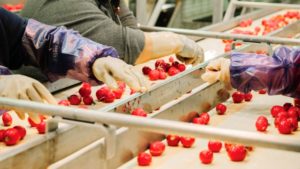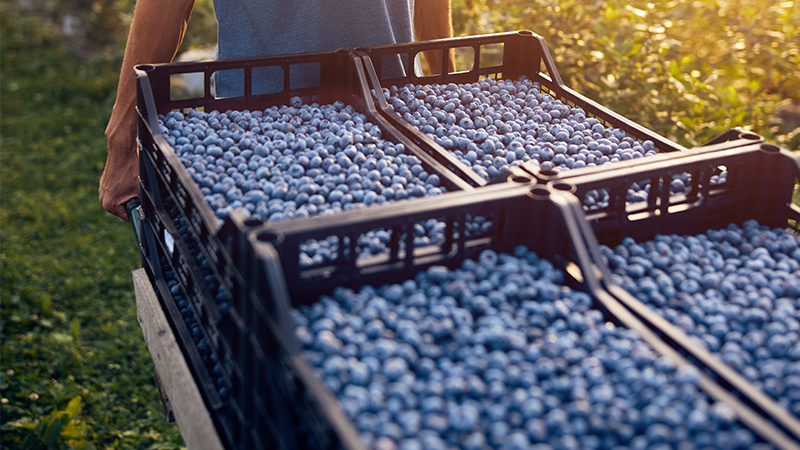Take the Stress out of Food Safety Inspections

Felipe Gallardo harvesting collard greens at Buurma Farms.
A lot of growers understandably hate food safety inspections. While everyone wants to keep produce safe for public consumption, the regulations and paperwork involved spark complaints like few other issues.

Joel Buurma
Joel Buurma isn’t likely to join in on the complaints. He heads up his family’s operation’s food safety program, and Willard, OH-based Buurma Farms has an excellent track record with food safety.
And the system he has in place is so straightforward, any farm can use it, helping take the hassle out of food safety inspections.
“Honestly, we try not to do anything different for the inspection,” Buurma says. “It’s an ongoing thing; you’ve got to be doing it all the time in order for it to actually work. We don’t try to hurry up and get ready for the audit.”
Step One: Make Food Safety a Priority
For Buurma, the food safety program is about much more than paperwork.
“Number one, we certainly don’t want to be responsible for ever making anyone sick or worse,” he says.
That’s a viewpoint everyone can get behind. But Buurma thinks that the extensive paperwork involved with food safety programs is a good thing, too.
“Whatever it is that happens, you want to do everything you can to show that you made every effort you could to prevent harm. Stuff still happens. You can’t prevent everything, but you’ve got to do your best to try,” he says.
And… “If you didn’t document, it didn’t happen,” Buurma says.
How the Buurma Food Safety Program Works
1. One Guy Is in Charge. Buurma heads up food safety for all Buurma Farms locations, which in addition to Ohio, are located in Michigan and Georgia.
In that role, he creates standard operating procedures (SOP), trains groups of employees, collects the ongoing paperwork, conducts internal inspections, and makes sure retraining takes place whenever he perceives any misunderstandings or weaknesses.
“I coordinate it, I oversee it,” Buurma says. “I create all the SOPs with input from other people. Hopefully, everyone is involved to a certain degree. A lot of people are in charge of their own areas, but the buck stops here.”
2. Crew bosses coordinate the program with their teams. Supervisors oversee the daily activity for the farm, packing shed, and shipping. So it only makes sense for them to track activity, sign off on when and where the crop interacted with equipment and people, and send it to Buurma, who keeps it on file.
3. Everything is on paper. While Buurma likes the idea of automating much of the paperwork involved with food safety, his operation isn’t ready for that step. First, much of the Buurma operation is not on WiFi. And second, he’s certain the wet and dirty conditions in the field will shorten the life of any electronics used, making it unreliable.
4. What’s tracked? Everything. “We use a traceability program for shipping, track every package down to the box level. We can tell you where it went and when it leaves here. We can trace each box, whether it was grown by us or purchased from a supplier, every step through our processes, all the way to when it was shipped and to whom. Or we can trace that back to the date and field it was harvested in and from there down when it was planted, the exact seed lot used, and everything that was done to it since,” Buurma says.
Which Guidelines Does Buurma Follow?
Buurma Farms works with Primus GFS and GlobalGAP for its audits. Primus provides the operation with the exact checklists that the auditor would use.
“It’s pretty extensive, there are four parts to it: Food Safety Management System; Good Agriculture Practices; Good Manufacturing Practices; and Hazard Analysis of Critical Control Points. Just the checklist is 66 pages, with about eight questions per page. The Standards, Guidelines, and Interpretations are significantly more than that.” Buurma says.
Setting the Policies
The biggest step to an effective program is getting written policies in place, Buurma says. They have to be thought through, and include every step that food safety programs require.
He ticks off an extensive list to illustrate his point:
“You can’t just do it. You have to have a procedure of exactly what you do, how you do it, when you do it, how often you chart, and have the documentation to show that has been done. You need to show it was approved — checking that it was done,” he says.
How does that get carried out realistically? Supply everyone in the company with what they need to follow the rules.
Buurma gives each key employee a booklet with the Buurma Farms’ policies as they apply to that individual. The booklet tends to have five or six SOPs that apply directly to that employee. So the booklet an irrigation crew boss receives will be markedly different from the one a tractor driver or line leaders in the packing shed will have.

Each employee understands how his or her actions can keep food safe or allow it to be contaminated.
Training Early and Often
There are two levels of training for Buurma employees. The first training takes place at the time of hire, typically at the beginning of the spring season each year. Even those crew members who have been through it time after time are included.
OSHA training is included in this annual refresher course. The food safety portion reviews the basics of food safety — including hand-washing, hygiene, and clothing.
“We use a video on food safety from Cornell University. It’s in both English and Spanish,” Buurma says.
Naturally, the training is documented. Employees sign a sheet saying they’ve read, understood, and will comply with all of Buurma’s policies. Then the paperwork is collected and filed.
For the second level of training, Buurma travels between the different operations, working with like groups of employees (tractor drivers together, for example).
“Most of these guys have been doing it for a long time, for more years than I’ve been around,” Buurma says. “So they go through it again every year as a refresher.”
Training doesn’t have to be a big deal, Buurma says.
“Call all the guys together on a break, or after their lunch, and just read through the policy. Or we can talk about things, do a demonstration, whatever it might take,” he says.
Self-Inspections
Buurma Farms conducts food safety self-inspections several times throughout the year. Buurma aims for quarterly self-inspections. Additionally, the operations undergoes state inspections and several customer audits each year.
“I generally plan for self-inspections at the beginning and in the middle of the season, with the third-party audit towards the end when all commodities we produce are in season, so all can be inspected at once,” Buurma says.
All of the self-inspections allow Buurma to spot any issues long before they become a problem.
“If I there’s something that needs to be addressed, we’ll do a retraining or we’ll modify our procedures if we feel that’s necessary,” he says.
Buurma’s System Put to the Test
Buurma says what he does is nothing special.
Perhaps, but it works.
A few years ago, the company had a scare when a random test by the State of Michigan showed a potential pathogen.
Michigan allows state inspectors to pull produce from store shelves for testing. It’s a practice growers aren’t happy with, since they have no control over what happens once produce is shipped.
Extensive further testing of the crop, the equipment, and the facility showed no signs of any pathogens.
“Of course, you go through and pull all of your documentation and show that you did everything you possibly could do right.”
Buurma Farms had all the documentation it needed to prove it was in compliance with food safety regulations.
While the incident didn’t lead to any regulatory fall out, the operation was still hit financially.
Out of an abundance of caution, Buurma Farms pulled the crop from the time the first sample was reported until they received the all clear. In this case, that meant they lost out on several weeks of shipping and selling the crop.
“You only have a short season. Any time you have something like this happen, it’s a big hit,” Buurma says.
Why the Extra Paperwork is Worth it
Buurma concedes all the signed papers showing that training happened, tracking when and by whom a crop was harvested, is a pain.
“There’s no doubt that it’s extra effort. It’s extra expense. It’s not fun, and nobody likes it,” he says. “But if something happens, you want all the documentation possible to be able to show you did things right. It’s an insurance policy as much as anything else. It’s a little extra work, but people get used to it, and they expect it now. You have to curry that kind of culture, that expectation, and follow up on it and make sure. That’s all there is to it.”









